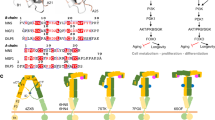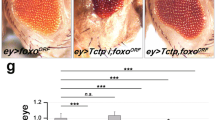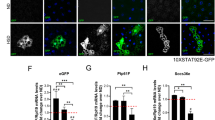Abstract
In metazoans, the insulin signalling pathway has a key function in regulating energy metabolism and organismal growth1. Its activation stimulates a highly conserved downstream kinase cascade that includes phosphatidylinositol-3-OH kinase (PI(3)K) and the serine–threonine protein kinase Akt. This study identifies a new component of insulin signalling in Drosophila, the steppke gene (step). step encodes a member of the cytohesin family of guanine nucleotide exchange factors (GEFs), which have been characterized as activators for ADP-ribosylation factor (ARF) GTPases2,3,4. In step mutant animals both cell size and cell number are reduced, resulting in decreased body size and body weight in larvae, pupae and adults. step acts upstream of PI(3)K and is required for the proper regulation of Akt and the transcription factor FOXO. Temporally controlled interference with the GEF activity of the Step protein by feeding the chemical inhibitor SecinH3 causes a block of insulin signalling and a phenocopy of the step mutant growth defect. Step represses its own expression and the synthesis of growth inhibitors such as the translational repressor 4E-BP. Our findings indicate a crucial role of an ARF–GEF in insulin signalling that has implications for understanding insulin-related disorders, such as diabetes and obesity.
This is a preview of subscription content, access via your institution
Access options
Subscribe to this journal
Receive 51 print issues and online access
$199.00 per year
only $3.90 per issue
Buy this article
- Purchase on Springer Link
- Instant access to full article PDF
Prices may be subject to local taxes which are calculated during checkout



Similar content being viewed by others
References
Hafen, E. Cancer, type 2 diabetes, and ageing: news from flies and worms. Swiss Med. Wkly 134, 711–719 (2004)
Jackson, C. L. & Casanova, J. E. Turning on ARF: the Sec7 family of guanine-nucleotide-exchange factors. Trends Cell Biol. 10, 60–67 (2000)
Randazzo, P. A. et al. Cytohesins and centaurins: mediators of PI 3-kinase regulated Arf signalling. Trends Biochem. Sci. 26, 220–221 (2001)
D’Souza-Schorey, C. & Chavrier, P. ARF proteins: roles in membrane traffic and beyond. Nature Rev. Mol. Cell Biol. 7, 347–358 (2006)
Saltiel, A. R. New perspectives into the molecular pathogenesis and treatment of type 2 diabetes. Cell 104, 517–529 (2001)
Virkamaki, A., Ueki, K. & Kahn, C. R. Protein–protein interaction in insulin signalling and the molecular mechanisms of insulin resistance. J. Clin. Invest. 103, 931–943 (1999)
Brogiolo, W. et al. An evolutionarily conserved function of the Drosophila insulin receptor and insulin-like peptides in growth control. Curr. Biol. 11, 213–221 (2001)
Kolanus, W. et al. αLβ2 integrin/LFA-1 binding to ICAM-1 induced by cytohesin-1, a cytoplasmic regulatory molecule. Cell 86, 233–242 (1996)
Geiger, C. et al. Cytohesin-1 regulates β-2 integrin-mediated adhesion through both ARF-GEF function and interaction with LFA-1. EMBO J. 19, 2525–2536 (2000)
Lietzke, S. E. et al. Structural basis of 3-phosphoinositide recognition by pleckstrin homology domains. Mol. Cell 6, 385–394 (2000)
Gray, A., Van Der Kaay, J. & Downes, C. P. The pleckstrin homology domains of protein kinase B and GRP1 (general receptor for phosphoinositides-1) are sensitive and selective probes for the cellular detection of phosphatidylinositol 3,4-bisphosphate and/or phosphatidylinositol 3,4,5-trisphosphate. Biochem. J. 344, 929–936 (1999)
Britton, J. S. & Edgar, B. A. Environmental control of the cell cycle in Drosophila: nutrition activates mitotic and endoreplicative cells by distinct mechanisms. Development 125, 2149–2157 (1998)
Pierce, S. B. et al. dMyc is required for larval growth and endoreplication in Drosophila.. Development 131, 2317–2327 (2004)
Hafner, M. et al. Inhibition of cytohesins by SecinH3 leads to hepatic insulin resistance. Nature doi:10.1038/nature05415 (this issue).
Jünger, M. A. et al. The Drosophila forkhead transcription factor FOXO mediates the reduction in cell number associated with reduced insulin signalling. J. Biol. 2, 20 (2003)
Puig, O., Marr, M. T., Ruhf, M. L. & Tjian, R. Control of cell number by Drosophila FOXO: downstream and feedback regulation of the insulin receptor pathway. Genes Dev. 17, 2006–2020 (2003)
Bernal, A. & Kimbrell, D. A. Drosophila Thor participates in host immune defense and connects a translational regulator with innate immunity. Proc. Natl Acad. Sci. USA 97, 6019–6024 (2000)
Chen, C., Jack, J. & Garofalo, R. S. The Drosophila insulin receptor is required for normal growth. Endocrinology 137, 846–856 (1996)
Zinke, I., Schutz, C. S., Katzenberger, J. D., Bauer, M. & Pankratz, M. J. Nutrient control of gene expression in Drosophila: microarray analysis of starvation and sugar-dependent response. EMBO J. 21, 6162–6173 (2002)
Verdu, J., Buratovich, M. A., Wilder, E. L. & Birnbaum, M. J. Cell-autonomous regulation of cell and organ growth in Drosophila by Akt/PKB. Nature Cell Biol. 1, 500–506 (1999)
Leevers, S. J., Weinkove, D., MacDougall, L. K., Hafen, E. & Waterfield, M. D. The Drosophila phosphoinositide 3-kinase Dp110 promotes cell growth. EMBO J. 15, 6584–6594 (1996)
Goberdhan, D. C., Paricio, N., Goodman, E. C., Mlodzik, M. & Wilson, C. Drosophila tumor suppressor PTEN controls cell size and number by antagonizing the Chico/PI3-kinase signaling pathway. Genes Dev. 13, 3244–3258 (1999)
Weinkove, D., Neufeld, T. P., Twardzik, T., Waterfield, M. D. & Leevers, S. J. Regulation of imaginal disc cell size, cell number and organ size by Drosophila class I(A) phosphoinositide 3-kinase and its adaptor. Curr. Biol. 9, 1019–1029 (1999)
Gao, X., Neufeld, T. P. & Pan, D. Drosophila PTEN regulates cell growth and proliferation through PI3K-dependent and -independent pathways. Dev. Biol. 221, 404–418 (2000)
Stocker, H. et al. Living with lethal PIP3 levels: viability of flies lacking PTEN restored by a PH domain mutation in Akt/PKB. Science 295, 2088–2091 (2002)
Furuyama, T., Nakazawa, T., Nakano, I. & Mori, N. Identification of the differential distribution patterns of mRNAs and consensus binding sequences for mouse DAF-16 homologues. Biochem. J. 349, 629–634 (2000)
Xuan, Z. & Zhang, M. Q. From worm to human: bioinformatics approaches to identify FOXO target genes. Mech. Ageing Dev. 126, 209–215 (2005)
Kaufmann, E. & Knochel, W. Five years on the wings of fork head. Mech. Dev. 57, 3–20 (1996)
Acknowledgements
We thank W. Kolanus for valuable discussions on cytohesins; M. Famulok for providing the Step inhibitor SecinH3 and for sharing unpublished results; S. Cohen and M. Günther Behr for reagents; A. Schmitz for help with pAkt quantifications; C. Müller for technical assistance; and the members of the Famulok and Hoch laboratories for helpful comments. This work was supported by grants from the Deutsche Forschungsgemeinschaft, the Sonderforschungsbereiche 645 (to M.H.) and 704 (to M.H. and B.F.). Author Contributions T.B. and I.Z. performed the growth and body size analysis in step mutants. T.B. analysed the insulin signalling activity in step and chico mutants and under starvation using quantitative RT–PCR. B.F. performed the cell cycle analysis, cell size analysis in step mutants, pAkt quantifications, in vitro and in vivo FOXO localization studies, in vitro growth inhibition analysis, step enhancer analysis and ectopic FOXO expression experiments. I.Z. generated the in vivo chemical genetics data and the Dp110-CAAX rescue experiment. I.Z. and B.F. contributed to the step rescue experiment. M.H. supervised the research project, and assisted in the experimental design. All authors discussed the experimental results. B.F. and M.H. wrote the manuscript.
Author information
Authors and Affiliations
Corresponding author
Ethics declarations
Competing interests
Reprints and permissions information is available at www.nature.com/reprints. The authors declare no competing financial interests.
Supplementary information
Supplementary Information
This file contains complete Supplementary Information including Supplementary Methods, Supplementary Figures 1-7 and Supplementary Tables (PDF 947 kb)
Rights and permissions
About this article
Cite this article
Fuss, B., Becker, T., Zinke, I. et al. The cytohesin Steppke is essential for insulin signalling in Drosophila. Nature 444, 945–948 (2006). https://doi.org/10.1038/nature05412
Received:
Accepted:
Issue Date:
DOI: https://doi.org/10.1038/nature05412
This article is cited by
-
Cytohesin-3 is required for full insulin receptor signaling and controls body weight via lipid excretion
Scientific Reports (2019)
-
Slowed aging during reproductive dormancy is reflected in genome-wide transcriptome changes in Drosophila melanogaster
BMC Genomics (2016)
-
Two different pathways of phosphatidylcholine synthesis, the Kennedy Pathway and the Lands Cycle, differentially regulate cellular triacylglycerol storage
BMC Cell Biology (2014)
-
The Lnk/SH2B adaptor provides a fail-safe mechanism to establish the Insulin receptor-Chico interaction
Cell Communication and Signaling (2013)
-
ARF family G proteins and their regulators: roles in membrane transport, development and disease
Nature Reviews Molecular Cell Biology (2011)
Comments
By submitting a comment you agree to abide by our Terms and Community Guidelines. If you find something abusive or that does not comply with our terms or guidelines please flag it as inappropriate.



